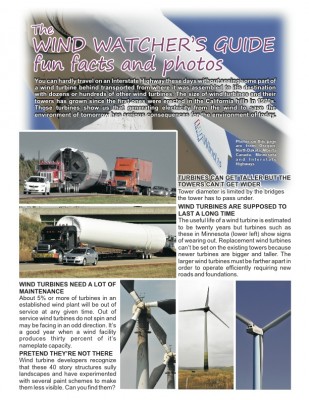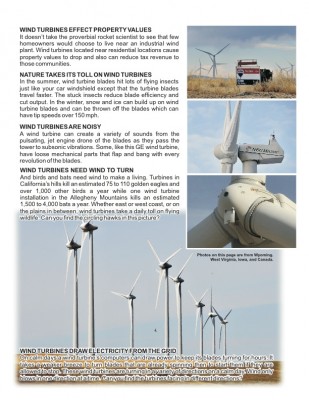Source:
Wind Watcher’s Guide: Fun facts and photos
Source:
Share:
Translate: FROM English | TO English
Translate: FROM English | TO English
You can hardly travel on an Interstate Highway these days without seeing some part of a wind turbine behind transported from where it was assembled to it’s destination with dozens or hundreds of other wind turbines. The size of wind turbines and their towers has grown since the first ones were erected in the California hills in 1970s. Those turbines show us that generating electricity from the wind to save the environment of tomorrow has serious consequences for the environment of today.


TURBINES CAN GET TALLER BUT THE TOWERS CAN’T GET WIDER
Tower diameter is limited by the bridges the tower has to pass under.
WIND TURBINES ARE SUPPOSED TO LAST A LONG TIME
The useful life of a wind turbine is estimated to be twenty years but turbines such as these in Minnesota (lower left) show signs of wearing out. Replacement wind turbines can’t be set on the existing towers because newer turbines are bigger and taller. The larger wind turbines must be farther apart in order to operate efficiently requiring new roads and foundations.
WIND TURBINES NEED A LOT OF MAINTENANCE
About 5% or more of turbines in an established wind plant will be out of service at any given time. Out of service wind turbines do not spin and may be facing in an odd direction. It’s a good year when a wind facility produces thirty percent of it’s nameplate capacity.
PRETEND THEY’RE NOT THERE
Wind turbine developers recognize that these 40 story structures sully landscapes and have experimented with several paint schemes to make them less visible. Can you find them?
WIND TURBINES EFFECT PROPERTY VALUES
It doesn’t take the proverbial rocket scientist to see that few homeowners would choose to live near an industrial wind plant. Wind turbines located near residential locations cause property values to drop and also can reduce tax revenue to those communities.
NATURE TAKES ITS TOLL ON WIND TURBINES
In the summer, wind turbine blades hit lots of flying insects just like your car windshield except that the turbine blades travel faster. The stuck insects reduce blade efficiency and cut output. In the winter, snow and ice can build up on wind turbine blades and can be thrown off the blades which can have tip speeds over 150 mph.
WIND TURBINES ARE NOISY
A wind turbine can create a variety of sounds from the pulsating, jet engine drone of the blades as they pass the tower to subsonic vibrations. Some, like this GE wind turbine, have loose mechanical parts that flap and bang with every revolution of the blades.
WIND TURBINES NEED WIND TO TURN
And birds and bats need wind to make a living. Turbines in California’s hills kill an estimated 75 to 110 golden eagles and over 1,000 other birds a year while one wind turbine installation in the Allegheny Mountains kills an estimated 1,500 to 4,000 bats a year. Whether east or west coast, or on the plains in between, wind turbines take a daily toll on flying wildlife. Can you find the circling hawks in this picture?
WIND TURBINES DRAW ELECTRICITY FROM THE GRID
On calm days a wind turbine’s computers can draw power to keep its blades turning for hours. It takes a weaker breeze to turn blades that are already spinning then to start them if they are allowed to stop. These wind turbines are turning in a variety of directions on a calm day. Wind only blows in one direction at a time. Can you find the turbines facing in different directions?

